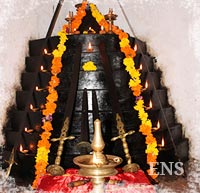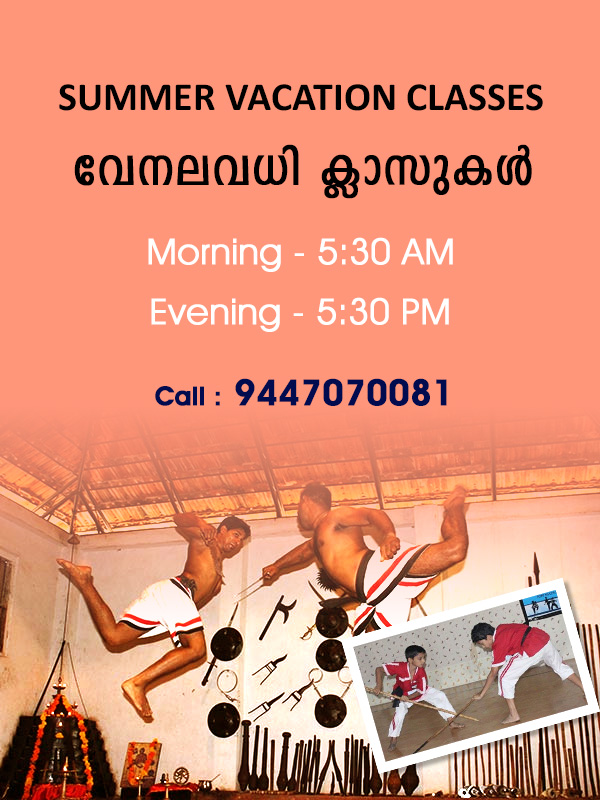History of Kalari

The institution of Kalari is generally traced to the period immediately after the disintegration of the Perumals of Kodungallur in the first quarter of 12th century AD.
It was an integral part of the socio-political system of medieval Kerala. Politically the land of Kerala was divided into a number of principalities and minor chieftaincies. The alignment and enmities of these power-centres resulted in constant warfare. Small scale skirmishes and large scale fighting were not uncommon among these local and regional authorities. In such a setup, each power centre was forced to maintain a body of fighters at its beck and call. Systematic training and strict rules of discipline for fighters were indispensable for an effective working of the system. It was in such circumstances that the body building and combat training provided by the Kalaris became not only necessary but essential.
Medieval principalities and chieftain familes maintained a military group of their own. This practice of maintaining trained local militia can be traced back to the period of the NADU formation in Kerala during the Perumal rule. Nadu chieftains had hundreds of organizations: MUNNURUVAR had 300, ANJUTTUVAR 500, ARUNUTTUVAR 600 and ELUNUTTUVAR 700. These bands of soldiers must have developed into landed aristocracy, supporting the established order with military power.
Here it is specially noted that the Kalarippayat training was undergone by every youth of the NAIR CASTE (the Kerala warrior caste that is like the SAMURAI of Japan). However Kalarippayat was not the sole prerogative of the Nairs, for there were many MUSLIMS, CHRISTIANS, EZHAVAS and even Brahmins [a sub-caste of Hindu religion] who practiced and mastered the techniques of Kalarippayat.
KALARI
In Sanskrit, the word KHALOORIKA denotes a place where weapons training is practiced. It is believed that it was from the Sanskrit term Khaloorika, that the word KALARI came into use in Malayalam to mean: an institution for imparting knowledge of and training in the martial arts. The term KALARI denotes a gymnasium for proper training or exercise, but in the present context it means training in the traditional style of combat.
This was the first educational centre in Kerala. Till the middle of this century, KALARI was the place for all sorts of education. It was the next important establishment in any Place in Kerala, next to the temple. The master of Kalari, better known as ASAN or GURUKKAL was one of most respected man of the society. Apart from physical training, he taught LANGUAGES, SCIENCE and ART. He was the local doctor, especially for the treatments of nerves and bones. Kalari has a separate system of MEDICINE & TREATMENT. This is the only Martial Art that contains RITUALS, EDUCATION & TREATMENT.
The Rituals include the worship of certain Hindu Gods inside the Kalari. The arena has to be in the area of God. Inside the arena, in the southwest corner, an altar is built for the presiding deity – a solemn concept. Alongside, a platform is constructed for GANAPATHY, the remover of obstacles. The divine serpents also find their place in this arena. One seat is arranged for four traditional masters and twenty-one subsidiary teachers. In addition, deities like VEERA BHADRA, BHADRA KALI, and VETTAKK ORU MAKAN are also invoked in astrologically designated corners like those of Meena [Pisces], Dhabi [Sagittarius] and Methuna [Gemini]. There are no other seats assigned for other individuals.
For the sanctity and safety of the Kalari, on an auspicious day, purificatory rituals such as VASTHU HOMA, SUDARSHANA HOMA, and GANAPATHY HOMA etc. are carried out. Outside the Kalari, sacrificial offerings are made to the horde of LORD SHIVA, in the eight directions, starting from the east. Next follows installation of the presiding deity, and worship at the altar. Then the master enters the arena paying his obeisance and lording the scene. This god–figure should clean the arena every dawn, prior to worship.
A lamp is lit before the altar and flowers beautify the scene. On a plantain–leaf, rice, betel nut, betel–nut leaves, beaten rice flakes, puffed rice, jigger, banana etc. are kept as offerings. Then with acceptance of the customary fees from the novices, the training commences. Before stepping on the arena, the learners turn their eye eastward in a symbolic obeisance to the traditional customs and rituals that have been incorporated for moulding mature minds, creating a generation who will grow up well–acquainted with traditions. Devotion, discipline, veneration and faith are all integral to Kalari.
The novice enters the Kalari putting his right foot forward, he bows and touches the sacred earth respectfully and prays to the presiding deities. He touches the master’s feet reverentially. These routine customs are followed both before and after the practice. The present generation, used to the superfluous teacher-student relationships of modern society may marvel at the strong and sincere master-disciple bonds in the Kalari system. In today’s hi-tech educational scenario, the teachers guides only in specialised areas, working merely on a contractual basis. The contract is valid only until the completion of the designated course of study, at which time the teacher–student bond also expires. In contrast, the master–disciple reciprocates a lifetime relationship which can extend across generations.
The education provided at the Kalari includes both physical & mental training. A Martial Art unique to Kerala, Kalari reigns above all other martial traditions in its scientific discipline. A graded daily practice results, not only in blooming physical health, but also in excellence in an outstanding martial style. It ensures the defence of oneself and of the nation.
The practice of yoga, another contribution by India, has caught the imagination of the world. The supreme physical flexibility and concentration attained thereby can be internalized by training in Kalari. Gradual control of breath is made possible through the “CHUVADUKKAL” [literally: measured footsteps], the basic factor of this discipline, forming the basic stance for the rest of the activities. As rhythm is to music, so are the “chuvadus” to Kalari. They are scientifically evolved special positions that help a Kalari practitioner to achieve physical ease, deftness of action and attentive focus etc. The consequent excellence helps an artist to steal the limelight in the other ethnic art forms like KATHAKALI, OTTAM THULLAL, KOLKALI POORAKKALI, and PARICHAMUTTUKALI etc.
It is believed that this most ancient martial culture evolved from Dhanur Veda, a subsection of Yajur Veda. Its roots are widespread in the Agnipuran [the fire scripture], Natya shastra, Hastanga shastra, Ayurveda [the science of life] etc. Kalari was an inevitable part of the medieval socio-political scene in Kerala where the provincial rulers patronised this for self-defence. Well trained Kalari youths formed the commandos of each principality.
Kalarippayatt is structured with rituals and tradition. An integral part of the Vedas, it mirrors the ancient Indian vision. Reflecting super human strength and brilliance, it is rooted in deep faith.
Kalari has come a long way since the times when it was used defensively to the modern perception that it is conducive to an individual’s physical and mental growth. Modern man is a prey to many diseases, thanks to a libertine life style. Diabetes, blood pressure, heart and abdominal diseases are all common. Despite the strides in science and technology there’s no light at the end of the tunnel for many diseases mostly precipitated by intense mental tension, the primary causative factor. Here Kalari comes to our rescue, whereby we can control the mind and keep the diseases at bay to a great extent. The scientifically structured arena is as sacred as a place of worship. Manners and customs are solemnly adhered to and physical purity is a pre-requisite for entering the Kalari. A certain diet and lifestyle are essential. Intoxication is to be avoided, as are extreme feeling like desire and anger.
The training is imparted in two phases: basic exercises consisting of acombination of pranayama and different yogi postures form the bulk of the first phase. The various steps and movements are all attuned to the various body parts. The excess fat can be removed and blood circulation regulated through such practices. The perfection attained thereby forms the starting point for the second phase when dangerous weapons [like the sword, the knife etc.] are wielded. Intense concentration, swiftness, muscular strength and exactitude can be developed by this art. A moment out of focus may cost one’s very life. The limbs must move along with the eyes. A firm mind in a firm body enhances our defence system.
This is only one side of the coin. The other aspect of the treatment of the diseases affecting our vital parts, such as fractures, bruises and wounds etc, can be easily attended to. The extent and degree of damage is determined. Treatment using different kinds of oils is imparted for three, four, seven or forty-one days (in that order). Diseases deserted by the allopathic stream have been treated successfully. It is pertinent to remember that the contemporary ideal ‘Health for all’ can be fulfilled to a great extent through Kalari.
The initiation usually starts at the age of SEVEN. The most important teaching method of Kalarippayatt is by verbal commands. In Malayalam it is known as VAYTHARI [‘Vay’ means mouth, ‘Thari’ means telling]. The golden age of Kalarippayatt was from 13th century to 18th century AD. It was with the arrival of the British that this traditional military practice was forbidden by law and gradually become virtually extinct.

 Online Class
Online Class